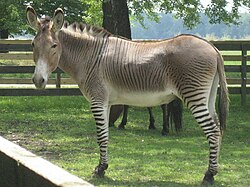Zebroide

Als Zebroide werden Hybriden innerhalb der Gattung Pferde aus Kreuzungen zwischen einem Zebra und einer anderen Pferdeart bezeichnet. Aus praktischen Gründen (einfachere Aufzucht) wird dabei als Vater meist ein Zebra verwendet. Wie die meisten Hybriden aus verschiedenen Arten, wie zum Beispiel Maultiere und Maulesel, sind auch Zebroide meist nicht fortpflanzungsfähig.
Kreuzungen mit Pferden
Zorse (Kofferwort aus zebra und horse) bezeichnet speziell die Kreuzung zwischen Pferd und Zebra, die meist eine größere Ähnlichkeit mit einem Pferd als einem Zebra aufweist. Zorse haben hologrammähnliche Streifen, die je nach Blickwinkel und Tageszeit ihre Form zu ändern scheinen.
Die erste erfolgreiche Kreuzung von Zebra und Pferd gelang Ilja Iwanowitsch Iwanow in Russland.[1]
Kreuzungen mit Eseln
Eine Kreuzung zwischen Zebra und Esel wird als Zebrule (von zebra und mule), Zedonk, Zebdonk bzw. Zonkey (von zebra und donkey) oder eingedeutscht als Zesel oder Zebresel bezeichnet. Das folgt dem Muster, dass bei Hybriden der Vater zuerst genannt wird. Fohlen einer Zebrastute sind – wegen des aggressiveren Paarungsverhaltens der Zebras – noch viel unwahrscheinlicher als solche einer Eselstute und werden Ebra genannt. Allerdings werden auch Fohlen eines Eselhengstes und einer Zebrastute in den Medien oft als Zebresel bezeichnet.[2][3]
Als Wildtier kommt der Esel-Zebra-Mischling in Afrika vereinzelt in Gegenden vor, in denen Zebras und Esel in enger Nachbarschaft leben.[4]
Bilder
- Zorse
- Zorse
- Zesel
- Zesel in Südafrika
- Zesel
- Zorse
- Zorse-Fohlen mit Mutter
Weblinks
- Heinz Milke: Wo sind Maulesel und Zebroide zu finden? uni-leipzig.de (Archiv)
Über einzelne Exemplare:
- Zebra-Pferdchen Eclyse: So ein Pferd haben Sie noch nie gesehen rp-online.de, 28. Juni 2007 – Bericht über ein Zebroid mit ungewöhnlicher Färbung im Safariland Stukenbrock
- Zufallskreuzung "Ebra" auf Kuba geboren Kleine Zeitung, 7. Juli 2011 – Zebra-Mutter und Esel-Vater leben im Zoo zusammen
Einzelnachweise
- ↑ Clive D. L. Wynne: Rosalià Abreu and the Apes of Havana. In: International Journal of Primatology, Band 29, Nr. 2, 2008, S. 298, doi:10.1007/s10764-008-9242-0.
- ↑ "Zebresel" in Zoo in Kuba geboren auf www.orf.at
- ↑ Mexiko: “Zebresel” im Zoo von Reynosa geboren auf www.latina-press.com
- ↑ Megersa, B.; Biffa, D.; Kumsa, B.: A mysterious zebra-donkey hybrid (zedonk or zonkey) produced under natural mating: A case report from Borana, southern Ethiopia. In: Animal Production Research Advances. 2. Jahrgang, Nr. 3, 2006, S. 148–154.
Auf dieser Seite verwendete Medien
Autor/Urheber: Ruth boraggina from Belleville, USA, Lizenz: CC BY 2.0
An Zonky: half zebra & half donkey.
Autor/Urheber: Whitney Carpenter., Lizenz: CC BY-SA 3.0
Zonkey, at Hennops 4x4 trail, Gauteng, South Africa. The zonkey is a cross between a zebra stallion and a donkey mare. Although, there has been a report that a zonkey has been created from a donkey stallion and a zebra mare in Barbados <3 (2005).
Autor/Urheber: Fährtenleser, Lizenz: CC BY-SA 4.0
Die Zorse-Stute (Zebroid) Eclyse im Safariland Stukenbrock. Geboren 2006, Mutter Zebra, Vater Pferd
A Zebroid mix between a Grevy Zebra and a Horse. I took this picture in Mt. Kenya Safari Club summer 2005 and I donate it to the public domain.
Romulus, the striped colt of a horse mother and zebra father
Identifier: evolutionanimall00jord (find matches)
Title: Evolution and animal life; an elementary discussion of facts, processes, laws and theories relating to the life and evolution of animals
Year: 1907 (1900s)
Authors: Jordan, David Starr, 1851-1931 Kellogg, Vernon L. (Vernon Lyman), 1867-1937
Subjects: Evolution
Publisher: New York, D. Appleton and Company
Contributing Library: MBLWHOI Library
Digitizing Sponsor: MBLWHOI Library
View Book Page: Book Viewer
About This Book: Catalog Entry
View All Images: All Images From Book
Click here to view book online to see this illustration in context in a browseable online version of this book.
Text Appearing Before Image:
that where a certain char-acter in the mother is represented in the father by one of oppo-site condition, as where the mother is very short, the father verytall, the mother a brunette, the father light-haired, a given childcan inherit the character in only one condition. That is, in allcases of biparental reproduction, and they compose the majorityof cases in both animal and plant kingdoms, the inherited char-acters cannot be all those possessed by both parents, but mustbe either those of one or the other, or a mosaic of them, or ablend or fusion of them. And this introduces us to that phase HEREDITY 183 of the study of the results of heredity which to-day is being mostinvestigated, the determination of the laws of inheritanceof characteristics. The similarity or dissimilarity of the two mating parents is amatter of much importance in regard to the results of inherit-ance. To produce a fertile mating the two parents have atleast to be nearly allied. We are accustomed to take this for
Text Appearing After Image:
FIG. 115.—Romulus, the striped colt of a horse mother and zebra father. (After Ewart.) granted, but the actual degree of phyletic relationship necessaryin fertile mating is a point of much biologic interest. In mostcases both parents must belong to the same species or kind, butamong animals and plants there have been noted exceptionsto this rule, these exceptions constituting the facts of hybridi-zation. Hybridism is practically limited to mating of differentspecies of the same genera. Only in a few recorded cases haveorganisms of different genera mated in nature with the produc-tion of offspring. In zoological gardens and menageries the 184 ETOLUTION AND ANIMAL LIFE race feeling of the confined animals seems to break down, andunusual cases of hybridism are occasionally noted. Also men-tion must be made of the artificial induction of the fertilizationof sea-urchin eggs by the sperm cells of starfishes (animals notonly of different genera but of different families), and a few othersi
Note About Images














